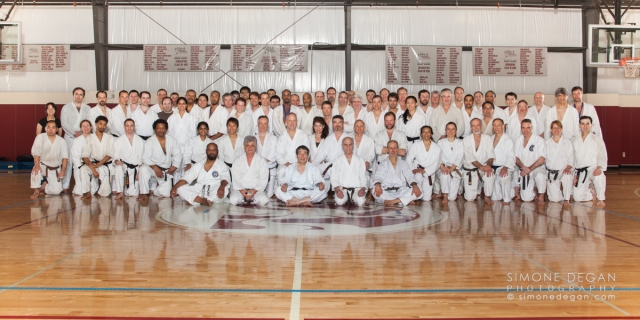
Spring in the South 2013 Group Photo. Photo by Simone Degan Photography.
The 34th annual Spring in the South was not, technically speaking, held in the spring this year. Nonetheless, the fair weather of springtime made an early (and temporary) emergence for the event. Our distinguished guest, Yasunori Ono, accompanied by his wife, Michiko, traveled from Tokyo to honor the Chapel Hill Dojo on its 35th anniversary. His fame as one of Mr. Ohshima’s most notable senior students preceded him; none of the nearly 100 attendees was disappointed with the dynamic, instructive and demanding practices.
SKA members arrived from along the East Coast (Montreal to Florida), across the Midwest, and even from California, including many beginners as well as seasoned veterans of this event. While the practices focused on basic, elementary movements and established ki in attacks, they were, at the same time, so utterly profound that striving to fully understand them will encompass years to come.
Each of the three practices began similarly. Instead of the general routine of stretching, we ran laps around the gym shouting “wasshoi!” a term difficult to translate and laden with cultural significance. Wasshoi seems to have developed in Edo (present day Tokyo), based on “wajo dokei,” which translates as “to unify the people’s hearts together and be full of enjoyment.” Over time it evolved to wasshoi, denoting the concept “to stay with harmony.”
Kata practice began with Heian Shodan before the group was divided into junior and senior members. The former completed several Heian kata, while the latter rotated through senior kata. Mr. Ono encouraged movement in unison, keeping rhythm with the senior leading each group.
Following this brief kata practice, Ono-san had everyone fan out around him in a semi-circle. His intent was to help us understand several basic and important elements, one of which was the back leg. He emphasized the importance of its being straight and connected to the ground, a point that Mr. Ohshima adamantly and endlessly teaches. Essentially, straightening the back leg assists in tilting the pelvis, shifting the hips to make forward movements easier and quicker.
Ono-san then became the attacker. Constantly changing the angle of his attack in order to reach as many members as possible; he afforded them the opportunity of sensing his oi-zuki or maete while the group tried to emulate his form, and simultaneously improve mental focus and speed. As he attacked, everyone attempted to match his level of energy, thereby elevating the spirit with each expression of our collective abilities. Ono-san repeatedly reminded us to eliminate tension and upper body power, a key requisite in moving quickly and fluidly. Another reminder of Mr. Ohshima’s teaching.
One image Ono-san used to explain how to move expeditiously was that of a wheel. He talked about tensing the musculature of the legs in readiness to attack, as if holding an imaginary wheel within a triangle formed by both legs and the tanden. This concept, he reiterated often, permits dynamic forward movement. Mr. Ohshima often uses a similar analogy in which the inner sensation of motion in the tanden resembles the constancy of a gyroscope.
